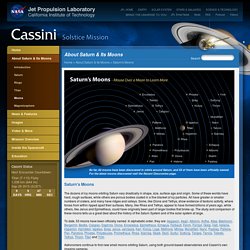

Saturn: Moons. Saturn, the sixth planet from the sun, is home to a vast array of intriguing and unique worlds.

From the cloud-shrouded surface of Titan to crater-riddled Phoebe, each of Saturn's moons tells another piece of the story surrounding the Saturn system. Christiaan Huygens discovered the first known moon of Saturn.
Outer Large Moons. Alkyonides. Inner Large Moons. Co-Orbital Moons. Ring Shepherds. Ring Moonlets. Moons of Saturn. Artist's concepts of the Saturnian ring–moon system Saturn, its rings and major icy moons—from Mimas to Rhea Images of several moons of Saturn.

From left to right: Mimas, Enceladus, Tethys, Dione, Rhea; Titan in the background; Iapetus (top) and irregularly shaped Hyperion (bottom). Some small moons are also shown. All to scale. The rings of Saturn are made up of objects ranging in size from microscopic to moonlets hundreds of meters across, each in its own orbit about the planet.[7] Thus a precise number of Saturnian moons cannot be given, as there is no objective boundary between the countless small anonymous objects that form Saturn's ring system and the larger objects that have been named as moons. Discovery and naming[edit] Early observations[edit] Observations by spacecraft[edit] Four moons of Saturn can be seen on this image by the Cassini spacecraft: Huge Titan and Dione at the bottom, small Prometheus (under the rings) and tiny Telesto above center.
Outer moons[edit] Naming[edit] Saturn's Moons. Saturn's Moons The dozens of icy moons orbiting Saturn vary drastically in shape, size, surface age and origin.

Some of these worlds have hard, rough surfaces, while others are porous bodies coated in a fine blanket of icy particles. All have greater or smaller numbers of craters, and many have ridges and valleys. Some, like Dione and Tethys, show evidence of tectonic activity, where forces from within ripped apart their surfaces. Many, like Rhea and Tethys, appear to have formed billions of years ago, while others, like Janus and Epimetheus, could have originally been part of larger bodies that broke up. To date, 53 moons have been officially named. Astronomers continue to find new small moons orbiting Saturn, using both ground-based observatories and Cassini's own imaging cameras. For more information on the latest moons discovered visit the Recent Discoveries page and the Icy Satellites publications listing. Diversity of Worlds The moons of Saturn are a diverse collection. Space Science - Saturn and Titan. Saturn and Titan, side by side Saturn and Titan 5 March 2012 Titan, Saturn’s largest moon at 5150 km across, looks small here, pictured to the right of the gas giant in this infrared image taken by the Cassini spacecraft.

Saturn’s rings appear across the top of the image, casting shadows onto the planet across the middle of the image. A much smaller moon, Prometheus, 86 km across, appears as a tiny white speck above the rings in the far upper right of the image. The shadow of another moon, Pandora, 100 km at its widest, can be seen below the ring shadows towards the right side of the planet.